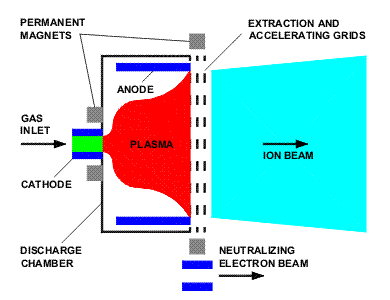XIPS (xenon-ion propulsion system)

Working principle of a XIPS.
XIPS (xenon-ion propulsion system) is a commercially-developed electron bombardment thruster (also known as an electrostatic ion thruster) – a form ion propulsion – that is a product of Hughes Space and Communications Company, which, in 2000, became part of Boeing Satellite Systems. XIPS (pronounced "zips") employs the heavy inert gas xenon as a propellant. It was first used operationally aboard the PAS-5 (PanAmSat-5) communications satellite in 1997 and has since been fitted to many other geosynchronous satellites for use primarily in station-keeping.
In a XIPS, xenon atoms are injected into an ionization chamber and ionized by electron bombardment. The propellant is then electrostatically accelerated through a series of biased grids.
Ions ejected by XIPS travel in a stream at a speed of 30 kilometers per second (62,900 mph), nearly 10 times that of a conventional chemical thruster. The high efficiency of the system leads to a reduction in propellant mass of up to 90% for a satellite designed for 12–15 years operation. Less propellant translates to a reduced launch cost, a bigger payload, or a longer satellite lifetime, or any combination of these. Because ion thrusters operate at lower force levels, attitude disturbances during thruster operation are reduced, simplifying the station-keeping task. Although the force and therefore the resulting acceleration delivered by an ion engine is small, over time it can enable the buildup of a high velocity, making this type of propulsion also useful for interplanetary probes. A larger, modified version of XIPS, known as NSTAR, was designed and manufactured by Hughes for NASA and used to power the Deep Space 1 and Dawn spacecraft.
Investigations of xenon-based ion thrusters began in 1984 at Hughes Research Laboratories, building on earlier work on ion engines carried out by Hughes and NASA. These investigations showed that xenon offered the highest thrust of any non-reactive gas; furthermore, being neither corrosive nor explosive, it poses no risk to spacecraft or to personnel loading the propellant tanks. PAS-5 became the first vehicle in space to be equipped with XIPS and was quickly followed by other satellites which use the system for station-keeping.
Boeing XIPS 601 HP and 702 thrusters
Whereas chemical thrusters are limited by how much energy is released during the combustion process, ion thrusters are dependent on the amount of electrical power available: more power means faster-moving ions and higher thrust. Boeing currently offers two different commercial xenon ion engines. The 601HP XIPS is 13 centimeters in diameter, uses 500 watts (W) of power, has a specific impulse of 2568 seconds, and produces a thrust of 18 millinewtons (mN). The larger 702 model is 25 centimeters in diameter, uses 4,500 W, has a specific impulse of 3,500 sec, and gives a thrust of 165 millinewtons.
A typical satellite uses up to four XIPS thrusters (two primary, two redundant) for station-keeping, all connected to the same xenon supply. Each primary device is switched on and off by a smart power unit that monitors and diagnoses operations automatically. In normal operation, a 601HP thruster operates for about 5 hours per day, a 702 for about 30 minutes per day.
The 601HP can perform all north-south station-keeping and spacecraft momentum control in two axes. Orbit and momentum control are accomplished through a series of two burns on each day of the station-keeping cycle. The 702, on the other hand, uses its high-power capacity to carry out all station-keeping and spacecraft momentum control. On-orbit mission maneuvers are achieved with a series of four daily burns, providing precise orbit control. This strategy maintains a ±0.005 degree station-keeping box, allowing for collocation of many satellites in a single orbital slot.
The 702 also offers the option of XIPS orbit-raising. Using XIPS to augment transfer orbit further reduces the amount of chemical propellant loaded. Larger payloads can thus be accommodated, with greater flexibility in the choice and use of a launch vehicle. Chemical propellant is used to place the satellite into a supersynchronous elliptical transfer orbit, and pre-programmed XIPS maneuvers are used to circularize the orbit and position the satellite in its final orbit.


